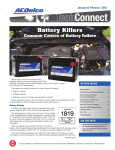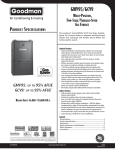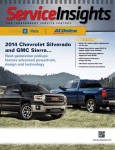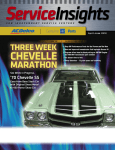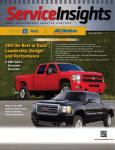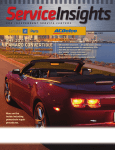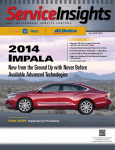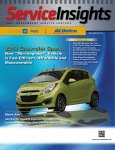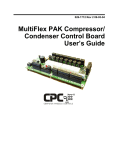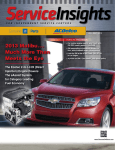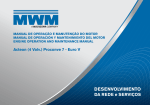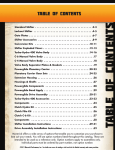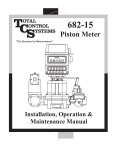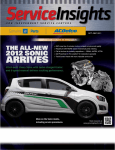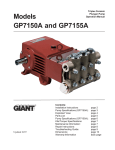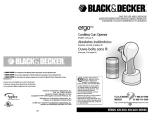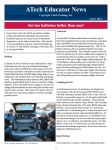Download July/September 2010 - GM Service Insights
Transcript
ServiceInsights F O R I N D E P E N D E N T S E R V I C E C E N T E R S July–Sept 2010 > For heavier haulin’, it’s the 8.1L > GM 4T65E reman comes with lower prices > New V5 A/C Compressors now available > New E-Rod for manual transmissions introduced > GM at AAPEX, come see > Volt comes nearer to reality > LA resto shop creates the classics with GM power > TECHconnect insert with valuable repair info New ’Vette’s Launch Control feature optimizes traction for greater and more consistent on-track performance. Details on page 7. CONTENTS GM Parts Product Update 3 The Technical Side The latest word on product development and technologies. 7 Discover new ways to approach service and repairs. Repair Industry News & Updates 6 Business of Repairs Get state-of-theindustry perspectives from GM insiders. 10 New ideas that can benefit how your shop operates and profits. GM ServiceInsights Online More Genuine GM Parts resources and links. Download this issue and past issues of GM ServiceInsights magazine at... www.gmserviceinsights.com GM ServiceInsights Headquarters 2604 N.E. Industrial Dr., #230 N. Kansas City, MO 64117 E-mail: [email protected] Compliments of your GM dealer. We invite your input and suggestions. Please address letters to the editor to the above address. Letters submitted imply the right to edit and publish. Every effort is made to ensure the accuracy of the information in the offers contained in this magazine. However, printing and typographical errors may occur. These are not intentional and are not the responsibility of GM, any GM dealer, or the companies or individuals who create, produce and distribute this magazine. Offers and pricing may change at any time without prior notification. The descriptions and specifications in this publication were in effect at the time of approval for printing. General Motors reserves the right to change specifications without notice and without obligation. Published letters do not necessarily reflect the opinions of General Motors, General Motors Parts, General Motors LLC, Detroit, MI 48202. 2010 General Motors LLC. All rights reserved. Product Update New GM reman 8.1L V-8 targets “heavier-duty” rebuild/replace market Owners of many classes of GM work trucks, vans, pick-ups and SUVs will now have a remanufactured GM engine alternative to rebuilding or replacing the original engine. The newly released reman 8.1L, 496-cubic-inch V-8 engine is designed for GM heavy-duty pickups, full-size vans and light- and medium-duty trucks in GMC and Chevrolet model years 2001-2009. Models include Kodiak, Topkick, Suburban, Avalanche, Yukon, Escalade, Express, Savana and many medium-duty applications. The long-block engines, based on the L18-code “bigblock,” offer an economical alternative to rebuilding while duplicating the performance characteristics of the stock engine. They’re designed to install easily, allowing for the simple transfer of accessories and components like the oil pan, valve covers and balancer. GM followed its standard rebuilding process in designing the new release. It comes with remanufactured components including the cylinder block, rotating assembly and cylinder heads, as well as new bearings, seals, gaskets, intake and exhaust valves, hydraulic roller lifters, graphiteanodized coated hypereutectic pistons, premium piston rings and timing chain. GM is offering the engine in multiple configurations. All except one (part number 12491673) are both gasoline and CNG/LPG-capable (KL5-equipped). • Part number 19211051 is for model 2007-2009 vehicles and requires the purchase of a new oil pump and screen. • Part number 19168066 is model year 2004-2006 applications, and requires purchase of an applicationspecific new oil pump assembly and screen. • Part number 12491673 is for 2001-2003 gasoline applications. It includes a high-volume oil pump assembly. • Part number 88984300 is for 2001-2003 applications, and comes with a high-volume oil pump assembly. All engines carry GM’s 3-year/100,000-mile Service Replacement Powertrain Limited Warranty. The engines are emissions certified for direct replacement in all 50 states. Vortec 8.1L V-8, 2008 (L18) medium-duty (LRZ option) for the GMC Topkick July – Sept 2010 ServiceInsights 3 GM Parts Product Update (cont’d.) GM’s popular front-wheel-drive transmission, the 4T65E, available at new lower pricing! Since 1997, more than 8 million Buick, Chevrolet, Oldsmobile, Pontiac and Saturn passenger cars and minivans have been equipped with GM’s HydraMatic 4T65E four-speed, electronically controlled transmission. Now, remanufactured versions of the 4T65E are available at new, attractive pricing to respond to the growing number of consumers choosing to repair or replace major powertrain components on aging vehicles. NEW V5 COMPRESSORS offer more A/C repair choices. GM has unveiled a new option for replacing V5 air conditioning compressors in older GM vehicles. As of May, service providers can now purchase new, ACDelco-branded V5 compressors that conform to original equipment specifications. With these compressors, shops now have another choice besides a remanufactured aftermarket V5 or a more expensive GM OES version. The new V5 is available in 17 part numbers that cover the most common V5 GM applications. The V5 compressor was installed 4 July – Sept 2010 ServiceInsights Always the Right Fit With a remanufactured version of the 4T65E transmission, your customers are assured of getting a plug-and-play transmission that exactly fits their vehicle and is enhanced with the most up-to-date GM Powertrain transmission technology. For more information on pricing and availability of the GM Reman 4T65E transmission, call 866-637-2787, or contact your GM dealer. in many small- and medium-sized GM vehicles built from the late 1980s through the mid-2000s. The ACDelco product is a 5-cylinder variable displacement, wobble-plate design that incorporates many of the same features as the OE products. With a tinplated forged aluminum swash plate, swagged connecting rod joints and a helical upstroke spring, the compressor meets OE performance and durability standards. Available through GM dealers, the compressor gives shops a chance to replace old V5 units with a mid-range solution. “This gives shops an opportunity to offer a less expensive repair option for customers with older vehicles,” says Ted Brundle, GM product specialist. “And since this is new equipment, it relieves repairers of having to deal with core charge issues on a remanufactured unit.” NEW E-ROD crate engine targets sticklers for sticks. A new version of the environmentallyconscious 6.2L LS3 crate engine has been calibrated to pair with most manual transmissions, opening up the E-ROD line to more applications and enthusiast preferences. GM Performance Parts (GMPP) engineers have succeeded in expanding the versatility and appeal of the ground-breaking E-ROD emissions-compliant crate engine package by calibrating it to work with most manual transmissions. The LS3 manual E-ROD package carries the same list price and comes with the same parts as the automatic LS3 version, which is rated at 430 horsepower. The difference is the programming of the electronic control module, allowing the engine to work with a manual gearbox. GMPP recommends pairing the engine with the six-speed manual — part number 92236241 — that comes in the current model-year Camaro. “The manual version allows car builders to go with a wider selection of powertrains,” according to Dr. Jamie Meyer, GMPP product marketing manager. “A stick shift is ideal for muscle cars, sports cars, kit car builders and off-roaders who may like a manual.” “The engine follows the standard LS bolting pattern and works with a wide selection of clutches and flywheels that can be purchased through any GM dealer.” Already, the manual E-ROD has attracted the interest of the off-roading community. Meyer says Four Wheeler magazine has outfitted a Jeep CJ8 with one. Additionally, 4Wheel & Off-Road magazine is doing a Jeep CJ8 project vehicle with an E-ROD paired with a 4L85E automatic. “The LS platform is very popular in off-road circles, and they think that the E-ROD could have a huge impact in off-road truck applications because off-roaders are very sensitive to the environment as well as performance,” Meyer noted. For additional information on the E-ROD, go to www.gmperformanceparts.com. The new E-ROD LS3 crate engine is efficient, environmentally-conscious and emission–compliant. July – Sept 2010 ServiceInsights 5 SPECIAL INSERT Repair Industry News & Updates GM at AAPEX 2010 GM plans big AAPEX splash with ACDelco line. GM Customer Care and Aftersales is planning to have a high profile at the 2010 Automotive Aftermarket Products Expo (AAPEX), scheduled for this November at the Sands Expo Center in Las Vegas. ACDelco will be carrying the GM banner at the Nov. 2–4 event, touting its new branding and market penetration strategy designed to appeal to multiple sectors of the automotive aftermarket. Spokesperson Curt Collins says GM will emphasize ACDelco’s renewed commitment to providing the products, training and e-business marketing services independent service centers value. “We’re introducing a tiered branding strategy for the ACDelco brand and we’ll be showing off some of the new parts lines we’ll be offering, like ACDelco Advantage Friction (brake) products, as well as Professional and OE service,” Collins says. GM’s display area also will likely feature a buzz worthy new vehicle, possibly a CTS-V Cadillac coupe. “It will be good to be back at the show and have the opportunity to meet our customers and share with them what we’re doing with the ACDelco line,” Collins says. 6 July – Sept 2010 ServiceInsights Volt Countdown Continues Chevrolet Plug-In will open new era in powertrain/propulsion technology. Come November 2010, the world’s first commercial plug-in hybrid electric vehicle, the 2011 Chevrolet Volt, will make its debut and usher in a new chapter in automotive technology. The essential difference between the Volt and other types of hybrid vehicles is that propulsion is provided exclusively by its 120-kw electric motor. A 16-kw lithium ion battery linked to a plug-in charger powers the motor for the first 40 miles; after that, during extended-range mode that adds another 300 miles of reach, it comes from an onboard generator powered by a four-cylinder, 1.4L engine connected to two fuel-storage tanks with a combined 12-gallon capacity. The engine and generator activate when 70 percent of the battery’s charge is depleted. In addition to powering the motor during extended range mode, the generator returns some energy to the battery. Energy also is captured via regenerative braking in both electric mode and extended-range mode. Although its energy source is electricity, not an internal combustion engine, the Volt is designed not to skip a beat in performance. Rated at 150-horsepower, the electric motor is capable of attaining 60 mph in less than nine seconds, and a top speed of 100 mph. July & August 2010 Internal Combustion Engine Technology Seminars • Spark Ignition Direct Injection (S-EM01-03.01SEM) The technology being introduced in the internal combustion engine has delivered a smarter working engine producing fewer emissions, resulting in engines that are more efficient, yet more powerful, than ever before. Emissions standards continue to become stricter each year. Internal engine design changes and exhaust aftertreatment are some of the ways those new standards are being met. The new technology of the modern internal combustion engine is highlighted in four new modular ACDelco seminars. Designed to be offered as one-hour “Lunch-and-Learn” training events, they can be delivered as onehour stand-alone courses or combined to provide an in-depth training program for your service center. The new Internal Combustion Engine Technology seminars are: • Homogenous Charge Compression Ignition (S-EM01-04.01SEM) Advanced Variable Valve Timing Variable Valve Timing (VVT), also known as cam phasing, dynamically changes valve timing events relative to piston timing by controlling the camshaft. By advancing or retarding cam timing, the engine can improve low-end torque, high-end horsepower or light-load fuel economy — all while reducing emissions. • Advanced Variable Valve Timing (S-EM01-01.01SEM) • Camshaft Variable Lift Systems and Active Fuel Management (S-EM01-02.01SEM) The seminar covers the operation of the different types of cam phasing devices: spline phaser in overhead cam engines, and vane phasers in overhead cam engines and cam-in-block engines. System testing and service precautions are reviewed as well. continued on page 2 New Duramax Diesel Engines IN THIS ISSUE Compared with the emissions of gasoline engines, diesels have typically offered benefits, particularly in hydrocarbons and carbon monoxide. But controlling nitrogen oxides (NOx) and particulate mass (PM) have been challenging. New emission regulation changes in the U.S., Canada and Europe require substantial NOx reduction. Meeting these new requirements by engine hardware changes alone has proven to be extremely difficult. However, the advanced aftertreatment technologies of the new Duramax diesel engines have shown great effectiveness in dealing with these emissions. Two new Duramax diesel engines were developed to meet the 2010 Federal emission Internal Combustion Engine Technology Seminars . . . . . . . . . . . . . . . . . . . .1 standards for oxides of nitrogen (NOx) and particulate matter (PM). They reduce NOx to 0.2 grams per brake horsepower per hour (g/bhp-hr). The 2007 standard was 1.2 (g/bhp-hr). New Duramax Diesel Engines . . . . . . . . . . . . .1 Clean Diesel Exhaust Chemistry. . . . . . . . . . . .4 Engine Applications The 6.6L Duramax diesel engine (RPO LGH, VIN code L) is used on 2010 interim and 2011 Chevrolet Express and GMC Savana vans and 2011 Chevrolet Silverado and GMC Sierra trucks with RPO ZW9 (chassis cabs or trucks with pickup box delete). The 6.6L Duramax diesel engine (RPO LML, VIN code 8) is used on 2011 Chevrolet Silverado and GMC Sierra pickup models. Mechanical Features These engines use an iron block and aluminum cylinder heads. The bore and stroke are continued on page 3 Getting into the Reprogramming Business . . . . . . . . . . . . . . . . . . . . . . . . . . . . . . .5 Tech Tips . . . . . . . . . . . . . . . . . . . . . . . . . . . 6 & 7 Training Update . . . . . . . . . . . . . . . . . . . . . . . . .8 New Online Virtual Classroom Training . . . . .8 ON THE WEB – www.acdelcotechconnect.com, click the TechConnect Magazine link, or – Log in to the ACDelco LMS, click the Resources link Engine Technology Seminars — continued from page 1 Camshaft Variable Lift Systems and Active Fuel Management A camshaft variable lift system is an advanced variable valve actuation technology that changes valve lift, duration and timing. In this seminar, the operation of several different valve lifter systems is covered, including a look at the roles of various components such as the valve lifter, oil switching valve, and engine oil pressure switch/oil temperature sensor. The seminar covers the SIDI operating modes and the combustion process. It also highlights the operation and components of the fuel system, including the fuel rail, fuel rail pressure sensor, high pressure fuel line, high pressure fuel pump, low pressure line, and high pressure fuel injectors. A new fuel injector technology — piezoelectric injectors — also is covered. These high voltage injectors use piezo crystal actuators that switch five times faster than a solenoid operated injector. Homogenous Charge Compression Ignition Vane phaser in a cam-in-block engine The Homogeneous Charge Compression Ignition (HCCI) is a combustion system where a homogeneous air/fuel mixture is ignited by compression. It has the potential to improve efficiency without requiring complex lean exhaust aftertreatment, helping to deliver a fuel savings of 15%. In addition, the seminar reviews the GM Active Fuel Management system, which deactivates four of the eight engine cylinders during certain driving conditions to reduce fuel use. It explains, for example, the operation of the valve lifters — eight for deactivation and eight for non-deactivation — in V8 mode and V4 mode. Publisher: Mike DeSander ACDelco E-mail [email protected] Editor: Mike Militello ACDelco E-mail [email protected] Technical Editor: Mark Spencer E-mail [email protected] Desktop Publishing: 5by5 Design LLC E-mail [email protected] HCCI combustion This seminar reviews the operation of HCCI technology as well as the valvetrain and injection strategy used in a HCCI engine. Since HCCI combustion is sensitive to a number of factors, such as climate, humidity and fuel composition, a variety of injection parameters and valvetrain adjustments are made during operation. Learn More In addition to the new engine technology seminars, ACDelco offers on-demand, online, Web-based courses and a variety of instructor-led, hands-on courses. To review the latest training courses available, log in to the ACDelco Learning Management System (LMS) at www.acdelcotraining.com. In the stratified-charge mode, combustion is in a limited area during the power stroke. ACDelco TechConnect is published bi-monthly and online for technicians of Total Service Support (TSS) and Key Fleet accounts to provide timely service information, increase knowledge and improve the performance of the service center. ACDelco 360 represents our mission to look at our businesses at every possible angle to provide value and assistance to our distributors and their customers as well as offer a full circle of support with programs, tools, training and marketing focused on enhancing and growing our partnership successfully. Production Manager: Marie Meredith Spark Ignition Direct Injection Mechanical direct fuel injection was first used in passenger cars in 1952. The Spark Ignition Direct Injection (SIDI) system in today’s engines offers the advantages of smaller displacement engines, improved efficiency and reduced emissions. SIDI delivers fuel directly into the combustion chambers during the intake stroke, which is ignited by the spark plug to begin combustion. Volume 17, Number 4 (TS-PU-0016-10) To learn when ACDelco seminars will be scheduled in your area, contact your local ACDelco distributor. – Thanks to Mike Militello 2 TECH CONNECT Write to: ACDelco TechConnect P.O. Box 500 Troy, MI 48007-0500 On the Web: To read and search recent issues of TechConnect online: – www.acdelcotechconnect.com, click the TechConnect Magazine link, or – Log in to the ACDelco LMS, click the Resources link ACDelco service tips are intended for use by professional technicians, not a “do-it-yourselfer.” They are written to inform those technicians of conditions that may occur on some vehicles, or to provide information that could assist in the proper service of a vehicle. Properly trained technicians have the equipment, tools, safety instructions and know-how to do a job properly and safely. If a condition is described, it cannot be assumed that the information applies to all vehicles or that all vehicles will have that condition. All materials and programs described in this magazine are subject to change. Submission of materials implies the right to edit and publish. Inclusion in the publication is not necessarily an endorsement of the individual or the company. TechConnect is published for ACDelco by Sandy Corporation, Troy, MI. ©2010 ACDelco. All rights reserved. New Duramax Diesel Engines — continued from page 1 unchanged. The main bearing has been changed to enhance oil film thickness, and oil pump flow is increased. In the cooling system, the thermostat is equipped with bleed holes to improve bleeding air from the system. The thermostat must be positioned with the bleed holes oriented toward the front of the engine. Orient the thermostat with the bleed holes toward the front of the engine An oval air filter is used on vans and a flat panel air filter is used on pickups. Also on pickups, the charge air cooler system has plastic lock rings on the inlet and outlet ducts. Twist the lock ring counterclockwise to release the tabs. A single variable nozzle turbocharger (VNT) is used. The oil feed has been relocated from the number 4 cam bearing to a dedicated supply port at the left rear of the engine valley. The EGR valve and stepper motor are contained in one unit. The position sensor now reflects the true position of the valve — the valve moves when the stepper motor extends or retracts. A single EGR cooler is used on the LGH engine for Express and Savana van applications, and a dual cooler is used on the LGH engine for Silverado and Sierra truck applications. The LML engine for the pickups also uses a dual cooler with an EGR cooler bypass controlled by the ECM to prevent coking of the EGR cooler during light load and idling. Fuel System Features The fuel system supply side is equipped with a fuel filter vacuum switch near the fuel filter. The switch opens if there is a restriction on the supply side, indicated by a vacuum of 13.6–15 Hg. The fuel system high pressure side uses a two-chamber pump that generates 200 megaPascals (mPa) of pressure (29,000 psi). Two high pressure lines feed the right fuel rail. A transfer tube carries fuel to the left fuel rail. A Fuel Rail Pressure sensor (FRP) is located on the rear of the left fuel rail. The high pressure pump is timed so the peak pressure pulses match the injection events. Matching the pressure pulses results in a more constant pressure within the fuel rails. If the pump is removed, it must be retimed when it is installed. There are timing marks on the pump gear and camshaft gear that must be aligned. Two Fuel Rail Pressure Regulators (FRPR) are used. FRPR 1 is still located on the injection pump as on previous Duramax engines. FRPR 2 is located on the front of the left fuel rail. This solenoid is normally open. The ECM supplies pulse width modulation to change the duty cycle of FRPR 2 to control the amount of fuel returned to the fuel tank. The new Duramax engines are equipped with Bosch piezoelectric fuel injectors. These injectors operate at high voltage, indicated by the orange color of the injector harness. Do not make contact with the fuel injector harness, ECM or fuel injectors while the ignition is in the On or Run position. Use certified, insulated Class 0 gloves rated at 1000 volts. Remember to check the expiration date of the gloves. The ECM supplies high voltage and provides a ground. Voltage is supplied up to 160 volts at 20 amps, and can peak up to 240 volts. This causes the injector to open. The capacitor discharges through an injector for initial opening and holds open with 12 volts. The piezoelectric fuel injectors operate at high voltage, indicated by the orange injector harness. Injectors are grouped into four pairs: 1-4, 6-7, 2-5, and 3-8. If a condition is detected in a group, that group is disabled and a DTC is set. On the fuel system return side, the return lines are now equipped with snap-in connections. The return side is under pressure. A pressure retention valve maintains 0.4 to 1.1 mPa of pressure within the return lines to provide proper fuel injector operation. Improper injector return line pressure may cause a no-start or performance concern. If the engine runs out of fuel, or if the fuel system is serviced, the system must be primed. After priming, a feed 3 TECH CONNECT Piezoelectric injector: A. Nozzle B. Control valve C. Hydraulic amplifier D. Piezo actuator E. High pressure supply line from the low pressure side of the pump backfills the injector return lines. The feed line will also backfill if pressure falls below 0.3 mPa in the injector return lines. Electronic Control Features The larger Bosch E86 ECM has three connectors instead of two. It also controls the HCI (Hydrocarbon Injector), FRPR 2, DEF pump, and DEF injector. The ECM has more than 160 new DTCs. The Glow Plug Control Module (GPCM) is located on the alternator bracket on the right side of the engine. The GPCM also provides regulated B+ for the NOx sensors and reductant heaters. Aftertreatment System The new Duramax diesel engines use an aftertreatment system to reduce oxides of nitrogen (NOx) by 90%. This system mixes automotive-grade urea — also known as Diesel Exhaust Fluid (DEF) — with NOx to convert the pollutants into nitrogen, water and trace amounts of CO2. The urea is quickly hydrolyzed to produce oxidizing ammonia. Two NOx sensors are used by the ECM to adjust DEF dosing in the exhaust system. The Diesel Particulate Filter (DPF) operates the same as on previous engines to remove diesel particulate matter, or soot, from the exhaust. The Hydrocarbon Injector (HCI) is located on the right side of the engine, with a nozzle located in the exhaust downpipe between the turbo and the Diesel Oxidation Catalyst (DOC). Diesel fuel is injected into the exhaust system ahead of the DOC to raise the temperature of the exhaust for DPF regeneration. The regeneration parameters are still based on time, distance, fuel and soot loading, but the algorithms used to determine regeneration now allow more time between generation events. – Thanks to Chris Graham, Kevin Larson and Bill Carnevale Clean Diesel Exhaust Chemistry In 2010, diesel engines sold in the U.S. are required to meet new Environmental Protection Agency (EPA) emissions requirements. To meet the standards for nitrogen oxide (NOx) reduction, the new Duramax Diesel engines in full-size GM trucks and vans feature a Selective Catalyst Reduction (SCR) system that uses automotive-grade urea — known as Diesel Exhaust Fluid (DEF) — that is mixed in the exhaust stream, causing a chemical reaction that converts the gases into mostly nitrogen and water. The DEF in the vehicle must be refilled periodically, similar to the fuel tank, but not as often. Diesel Emissions Control The SCR after-treatment system on the new Duramax Diesel engines causes NOx reduction reactions to occur in the exhaust stream. It’s called “selective” because it uses ammonia as a reductant to reduce NOx levels within a catalyst system. The Engine Control Module (ECM) controls the DEF delivery system. Based on the engine NOx emissions level communicated to the ECM by the NOx sensors, the ECM will send a command to the DEF injector to dose a After-treatment System A. Diesel Oxidation Catalyst (DOC) B. DEF injection and mixer C. Diesel Exhaust Fluid (DEF) D. Selective Catalyst Reduction (SCR) E. Diesel Particulate Filter (DPF) F. Exhaust cooler given quantity of DEF. The injected DEF combines with the exhaust gas with the help of mixers before contacting the SCR. The SCR brick stores the ammonia and through a chemical reaction with the NOx in the exhaust gas produces nitrogen (N2), water (H2O) and small amounts of carbon dioxide (CO2), which are natural elements common in the air. Driver Requirements The operation of the after-treatment system for NOx reduction is transparent to the driver. There is no change in vehicle performance or driveability. The only requirement of the driver is to replenish the DEF when the instrument cluster prompts to do so or at regular oil change intervals,whichever comes first. DEF usage is heavily dependent on drive cycles and will vary from vehicle to vehicle. The DEF fill location (identified by a blue cap) on GM full-size vans is next to the fuel filler and on GM full-size trucks is on the right rear side of the engine compartment. The nozzle diameter is smaller than the diesel fuel nozzle. Use the J23688 refractometer to test for DEF dilution. If DEF is contaminated with diesel fuel, the DEF system must be replaced. If the diesel fuel is contaminated with DEF, the water-in-fuel sensor should detect the contamination. Follow the appropriate diagnosis and repair procedures in the Service Information. Driver Warnings A number of driver warnings will display on the Driver Information Center to warn the driver that the DEF level is getting low and should be refilled. Several messages indicate the DEF mileage range that the vehicle will be able to travel before refilling. A new DEF warning symbol also will flash on the instrument cluster to communicate DEF system warnings. The Driver Information Center messages include: •Exhaust Fluid Range: XXX – displays available mileage range when the DEF is getting low •Exhaust Fluid Low Speed Limited Soon – displays when the DEF range falls below a specified range; speed will be limited when the DEF level becomes critical •Exhaust Fluid Empty Refill Now – displays when the DEF is empty; speed will be limited and other messages will display that provide more information. If these warnings are ignored, additional warning messages will display and the vehicle speed will continue to be severely limited. When adding DEF to an empty or very low tank, always add at least one gallon (3.78L) of fluid to release the vehicle from speed limitation. DEF Availability New DEF warning symbol Diesel Exhaust Fluid DEF is a colorless, clear solution of water and urea that has 32.5% +/- 0.7% of urea by weight. DEF also is referred to by other names such as AdBlue, ClearBlue, Urea, and Aus32 (Aqueous Urea Solution). The recommended temperature for storing DEF is between12°F – 86°F (-11°C – 30°C). To prevent DEF decomposition, it should not be transported or stored at temperatures above 77°F (25°C). The shelf life of DEF depends on storage temperature and exposure to sunlight. At a constant ambient storage temperature of 50°F, DEF may have a minimum shelf life of 36 months. But at a constant ambient storage temperature of 86°F, it may have a minimum shelf life of only 12 months. DEF also freezes below 12°F, but it may be reused once it thaws. Before using DEF, be sure to check every batch of fluid for potential evaporation. The DEF infrastructure is expected to grow over the next few years. DEF will be made available at dealerships, fuel stations, truckstops (pumps as well as small containers), and other locations that sell automotive fluids. DEF is available from ACDelco in one gallon, 10-4022 (19286291), and 2.5 gallon, 10-4023 (19286292), packages. –Thanks to Mike Militello 4 TECH CONNECT DEF is available from ACDelco Getting into the Reprogramming Business GM began service programming of Engine Control Modules (ECM) on some vehicles in the 1993 model year. By the 1996 model year, nearly 100% of GM vehicles had programmable ECMs. Soon after, Body Control Modules (BCM), ABS modules and other controllers were reprogrammable as well. Today, some GM vehicles, such as the 2010 Camaro, have as many as 38 reprogrammable controllers. That number will only continue to grow as more and more electronic features are added and electrical and communication systems become more sophisticated. For complete details on TIS 2 Web or to subscribe, go to www.acdelcotechconnect.com and click the TIS 2 Web link under GM Service Information on the left side of the page. Information about GM vehicles that have had updated calibrations for reprogramming released is available for free online. Go to tis2web.service.gm.com/tis2web to input a specific vehicle’s VIN; the site will return the vehicle’s calibration history. Reprogramming can be used by OE manufacturers to update module software to improve or modify operation. Most manufacturers now release software revisions regularly to update system operations, engine and transmission calibrations, and service part changes or replacements. For example, a simple repair procedure such as replacing a window regulator may require a window motor relearn procedure in the BCM to be performed using a scan tool. Return On Investment Many service centers have taken the first step to reprogramming by purchasing a J2534 tool for emissions-related issues. The SAE J2534 standard was designed to provide a low-cost reprogramming solution to the aftermarket that covers Powertrain Control Module and Transmission Control Module reprogramming for 2004 and newer vehicles. Reprogramming access for non-emissions-related modules is not mandatory, however, many manufacturers allow vehicle control modules to be reprogrammed. The next move is to determine how many repairs in your shop deal with reprogramming non-emissions-related components. The bottom line will be affected by your shop’s ability to sell reprogramming just like any other service. To determine how much of an investment would be needed to perform reprogramming, first add up the cost of any reprogramming equipment (diagnostic tool, interface device, software subscription). Next, determine how much the service center would charge the customer for reprogramming services (typically, this service ranges from $80 to $120) and subtract technician labor time to find your gross profit. Divide the investment costs by the gross profit to reveal the number of reprogramming jobs that it would take to break even. Programming Subscription TIS 2 Web is GM’s Web-based programming application and software that includes Service Programming Systems (SPS) for GM vehicles (required to reprogram GM vehicle control modules), Tech 2 scan tool software download, and the Tech 2 View and Tech 2 Snap Shot diagnostic applications. It can be used with generic J2534 devices. Several TIS 2 Web subscriptions are available: • Option 1– TIS-All (GM, Saturn, Saab) • Option 2 – TIS-SPS (GM, Saturn, Saab; service programming software only) • Option 3 – TIS-All Saab (Saab only) • Option 4 – TIS-Tech 2 Updates (Tech 2 software only) Vehicle calibration information is available free online. Tools and Equipment The equipment needed to perform complete reprogramming on GM vehicles includes a compliant J2534 interface device or scan tool with programming capability such as the Tech 2, as well as a computer with the appropriate operating system and a high-speed Internet connection. One available interface device is the Bosch Mastertech Vehicle Communication Interface (VCI), which is designed to connect the vehicle to a TIS 2 Web PC to transfer data and reprogramming calibrations to the vehicle control module. The VCI also offers domestic and Asian OEM scan tool functionality back to the 1996 model year as well as J2534-2 reprogramming. Tools for GM reprogramming can be purchased from Bosch Diagnostics, OTC or GM Dealer Equipment. For more information, go to www.acdelcotechconnect.com, click the TSS tab and select the Bosch diagnostics equipment link, or go to www.gmdesolutions.com/services. To review recommended computer hardware specifications and Internet connection guidelines, visit www.gmdesolutions.com/services/standards.php. More Information To learn more about service programming, there are several training programs available through the ACDelco Learning Management System, including hands-on courses, seminars and Web-based TechAssists. Go to www.acdelcotechconnect.com and click the Training tab. The NASTF website, www.nastf.org, also has a reprogramming section that lists manufacturers’ requirements and tool information. In addition, the ACDelco eBusiness Help Desk can answer questions regarding TIS 2 Web and service programming. Call 1-888-212-8959 for more information. – Thanks to Bob Stewart 5 TECH CONNECT The following technical tips provide repair information about specific conditions on a variety of vehicles. If you have a tough or unusual service repair, the TSS Technical Assistance Hot Line can help. Call 1-800-825-5886, prompt #2, to speak with a technical expert with the latest OEM information. Allison Transmission Shift Conditions The 2001-2007 Silverado Classic, Sierra Classic; 2007-2010 Silverado, Sierra; and 2003-2010 Kodiak and Topkick, equipped with the Allison LCT1000 transmission (RPO M74, MW7) may have a delayed engagement or no engagement into Drive, a delayed engagement or no engagement into Reverse, or a range inhibit with several possible DTCs. These conditions may be more pronounced in cold climates during a cold start. When DTC P0701, P0751, P0756, P0761, P0843, P0848, P0873, P0877 or P0894 set, it could indicate no or excessively low pump pressure as a result of a no prime or loss of prime condition within the transmission pump. Follow the diagnostic steps outlined in the Service Information. All of these DTCs, excluding P0894 could be set due to a fluid service/filter change, transmission service involving removing the pan, low fluid level caused by a leak, or long periods of storage. Also check the transmission fluid level using the Hot Check Procedure. Low fluid level may cause any of the listed DTCs to set, particularly during a cold ambient and cold vehicle start. In cold climates, ensure the fluid level is at the top of the HOT band. After checking the fluid level using the Hot Check Procedure, if any of the DTCs reset during a cold start, inspect the internal suction filter for possible cracks. Replacing the TCM will not likely correct any of the listed DTCs or low main line pressure. Inoperative, Intermittent or Noisy A/C Some owners of GM vehicles may comment that their A/C is inoperative, operates intermittently or is noisy. No DTCs are set. After further investigation and diagnosis, it may be determined necessary to replace the Thermal Expansion Valve (TXV). However, before replacing TXVs, always follow the A/C Performance Diagnostic in the Service Information to verify the valve performance and review the diagnostic tips. Possible causes of A/C noise: • Leaking interfaces (Incorrect fastening at TXV) – Fill system with correct charge. • Incorrect refrigerant charge – Fill system with correct charge. • Non-optimized TXV/ evaporator/plumbing – Verify if noise is being produced by the TXV or other A/C system components. Thermal Expansion Valve The TXV meters the amount of liquid refrigerant that can flow into the evaporator. Located at the evaporator inlet, the TXV is the dividing point between the high and the low pressure sides of the A/C system. As the refrigerant passes through the TXV, the refrigerant pressure is lowered. Due to the pressure differential, the liquid refrigerant will begin to boil at the TXV outlet before entering the evaporator core. This characteristic is observed as a drop in temperature between the TXV inlet tube and the evaporator inlet tube. TXV Failure Modes Possible causes of inoperative or intermittent A/C: • Bulb Sensor Temperatures on inlet and outlet tubes – Are the temperatures on both sides (inlet and outlet tubes) of the evaporator thermal expansion valve tube at the expansion device similar? If yes, replace the damaged or faulty thermal expansion valve. Pressures – Are both the low side and high side pressures within the specified values? Refer to the appropriate HVAC zone diagnostic. • Incorrect refrigerant charge – Diagnose and repair potential leak and/or fill A/C system with correct charge. • Leaking interfaces (Incorrect fastening at TXV or seal damage) – Apply correct torque or replace seals if necessary. • System contamination – Is the liquid line extremely cold at the expansion device location and warm beyond the expansion device location? The expansion device is restricted. Inspect for contamination (brown, powdery residue or metal flake) and replace TXV. 6 TECH CONNECT Brake Pedal Kickback 1997-2007 Ford E-Series; 1999-2008 Ford F-Super Duty; 2000-2005 Ford Excursion Some vehicles equipped with the Hydro-Boost brake booster system may exhibit a brake pedal kickback and/or grabbing condition when applying the brakes that may be caused by contamination within the power steering system. Filter the power steering fluid by installing a temporary filter in the power steering system in line with the power steering hose. The filter needs to go in the low pressure line that goes from gear to cooler to reservoir, where it would be most accessible. After the filtering procedure is completed, if the brake pedal kickback persists, it may be necessary to replace the Hydro-Boost brake booster. Diagnostic Assistance For free technical diagnostic assistance and product information regarding specific ACDelco products, contact these toll-free information hotlines staffed by ASE-certified technicians: Brakes – 1-888-701-6169 (prompt #1) Chassis – 1-888-701-6169 (prompt #2) Clutches – 1-888-725-8625 Lift Supports – 1-800-790-5438 Shocks – 1-877-466-7752 Starters and Alternators – 1-800-228-9672 Steering – 1-866-833-5567 Wiper Blades – 1-800-810-7096 The following technical tips provide repair information about specific conditions on a variety of vehicles. If you have a tough or unusual service repair, the TSS Technical Assistance Hot Line can help. Call 1-800-825-5886, prompt #2, to speak with a technical expert with the latest OEM information. Various Electrical Conditions 2005-2008 Cobalt, 2007-2008 G5 The following electrical issues may be evident on some models: SIR warning lamp illuminated, instrument panel lights flicker/inoperative, parking lamps flicker/inoperative, tail lamps dim/inoperative, trunk open lamp illuminated, radio inoperative, door lock inoperative, no start, or no crank. One possible cause of these conditions may be the interior wiring at the S361/J361 splice. Inspect splice S361/J361, parking lamp circuit, located in the body harness under the driver's seat. When installing a replacement rear leaf spring, technicians may notice a change in the diameter of the center alignment bolt on the replacement spring. Inspect the replacement spring center alignment bolt. If the head of the bolt measures approximately 15mm, it is a new design spring. Perform the following modification to allow installation of the replacement spring to the axle: 1. Obtain a 19/32" drill bit. Do not make a substitution for this drill bit size. Failure to use the specified size could alter the alignment of the vehicle and the driveline. 2. Carefully center the drill bit on the hole in the mounting plate on the axle and enlarge the hole. 3. Install the replacement spring, verifying proper fit to the axle. Power Steering Hose Retrofit Procedure 2006 Impala or Monte Carlo or 20052006 Grand Prix, with a V8 engine A. Body harness under the driver’s seat Remove the driver's seat from the vehicle and the driver's door opening carpet retainer. Peel back the carpet to about the "B" pillar and inspect the wires. If there is any damage, repair splice S361/J361 and other wires. Be sure to shrink-wrap any repairs to protect against moisture. If there is excessive moisture or water evident, water-test the vehicle for any leaks. Replacement Rear Leaf Spring 2004-2009 Colorado or Canyon When replacing the power steering hose, it's important to note that the new power steering hose is physically different than the original. The newly designed hose has a fin-type cooler built onto the hose assembly. UBEC Fuses 2006-2010 Impala and 2006-2007 Monte Carlo When diagnosing a condition with the turn signals, trunk actuator, courtesy lamps, or Brake Transmission Shift Interlock (BTSI), it may be possible to overlook some fuses in the Underhood Bussed Electrical Center (UBEC). The common architecture Body Control Module (BCM) uses several fuses for power, and the labeling of the fuses may be misread. • If the fuse in the UBEC labeled RT T/SIG is open, it will cause the right rear turn signal, the trunk actuator, and the BTSI to be inoperative. The right front turn signal will still function. • If the fuse in the UBEC labeled INT LIGHTS is open, it will cause the right front turn signal to be inoperative. The right rear turn signal will still function and the courtesy lamps will still function. • If the fuse in the UBEC labeled INT LTS/PNL DIM is open, the courtesy lamps will be inoperative. The instrument panel cluster backlighting will still function. Diagnostic Assistance New design power steering hose mounting locations The new design power steering hose should include installation instructions, which describe how to install the new design hose on vehicles that did not have this style hose previously. Per the installation instructions, it is necessary to drill mounting holes in the cradle to attach the new design hose assembly to the vehicle. Refer to GM bulletin #06-02-32-014 for more information. For free technical diagnostic assistance and product information regarding specific ACDelco products, contact these toll-free information hotlines staffed by ASE-certified technicians: Brakes – 1-888-701-6169 (prompt #1) Chassis – 1-888-701-6169 (prompt #2) Clutches – 1-888-725-8625 Lift Supports – 1-800-790-5438 Shocks – 1-877-466-7752 Starters and Alternators – 1-800-228-9672 Steering – 1-866-833-5567 Wiper Blades – 1-800-810-7096 Replacement spring 7 TECH CONNECT How to Take ACDelco Training Go to www.acdelcotechconnect.com and click on the Training tab to log on to the ACDelco Learning Management System (LMS). Course Number Course Name S-AC07-02.01ILT Automotive Air Conditioning: Advanced Refrigerant System Diagnostics S-AC07-03.01ILT HVAC Control System Operation and Diagnostics New VCT Training S-AC07-06.01ILT Toyota HVAC The new Virtual Classroom Training (VCT) courses enable participants to talk directly with instructors and other participants during the live training on the Web. The current VCT schedule includes the following courses. Click the VCT courses link to view the available courses and enroll. S-AC07-07.01ILT Chrysler HVAC S-BK05-01.01ILT Braking Systems S-EL06-04.02ILT Network Communication Diagnosis S-EL06-10.02ILT Electrical Power Management S-EL06-11.01ILT Automotive Electrical Circuit Diagnosis and Repair Course Number Course Name S-EL06-12.01ILT Hybrid Technology and Service S-EM01-01.01VCT Camshaft Position Actuator Systems S-EP08-02.01ILT Engine Performance: Computer Controls and Ignition System Diagnostics S-EM01-02.01VCT Active Fuel Management Operation S-EP08-03.01ILT Engine Performance: Air Induction and Fuel System Diagnostics S-FN00-01.01VCT How to Use VCT S-EP08-04.01ILT Engine Performance: Fault Monitoring and Emission System Diagnostics Current Instructor-Led Training S-EP08-05.01ILT Engine Performance: Advanced Drivability Diagnostics ACDelco’s Instructor-Led Training (ILT) courses provide hands-on instruction on the latest automotive systems. The following ILT courses are currently being held at training center locations around the country. Click the Schedule link on the LMS Menu to search the latest training schedule for courses held in your area. S-EP08-20.01ILT Toyota Engine Performance S-EP08-21.01ILT Chrysler Engine Performance S-EP08-81.01ILT Duramax 6600: Diesel Engine Performance S-SS04-01.01ILT Vibration Correction Diagnostics S-ST10-01.01ILT Supplemental Restraint Systems New Online Virtual Classroom Training Taking an online class with live interaction with an instructor is now a reality with ACDelco’s new Virtual Classroom Training (VCT) sessions. VCTs are a new learning technology that enables participants to engage directly with the instructor, other participants and subject matter experts along with viewing video and animations in a live classroom setting over the Internet. With VCTs, technicians who may find it difficult to attend traditional classroom training at a specific location will be able to sign up for classes that can be launched directly from their computer. receive a Past Cutoff Date message and will need to select another session. Upcoming technical VCTs will cover new repair and diagnostic techniques as well as specific instruction on a variety of service issues. What’s Needed to Participate How to Enroll Log in to www.acdelcotraining.com to enroll in a VCT just as you would for any other training program available through the ACDelco Learning Management System. Courses can be searched by clicking Menu > Schedule > Search Course Sessions. Enter the desired criteria and click Submit. Select the desired course. The system will list all available sessions of the selected course, including dates and times. VCT participants interact live with an instructor just as they would in a classroom setting. Enrollment in a VTC can be done up to one hour prior to the session start time. If you try to enroll in a session that starts within an hour, you will TS-PU-0016-10 8 TECH CONNECT It is important to make sure that the computers and connections used for VCT training meet the minimum requirements necessary to launch a course. To participate in a VCT, you will need: • PC headset with attached microphone • Standard Internet broadband connection • Windows 2000 Professional, Vista or XP • Internet Explorer 6 or higher • Adobe Flash Player 8 or higher • Screen resolution of 1024 x 768 For more information on the requirements for VCT, refer to the VCT User Guide located under Menu > Resources in www.acdelcotraining.com. – Thanks to Dan Carter The Technical Side More Like a Rocket on Wheels 2010 Corvette ZR1 with the 6.2L 638 HP Engine shares components with its C6.R racing cousin. The ZR1 may be just the ticket for performance car enthusiasts with an extra six figures or so in their pocket and a strong desire to routinely burn 0-60 in about 3.3 seconds. The ZR1 returns for 2010 with new Performance Traction Management (PTM) technology. It is an advanced system that is part of a new Launch Control feature that optimizes traction for greater and more consistent ontrack performance. The Corvette ZR1 is powered by a supercharged and intercooled 6.2L engine that is handassembled at GM’s Performance Build Center. It is rated at 638 horsepower (476 kW), making it the most powerful production car ever offered by Chevrolet and GM. Based on the Corvette ZR1 supercar, the GT2 Corvette C6.R has strong links to the production version of America’s performance icon. The GT rules require the use of many production-based components, expanding the opportunities for the two-way transfer of technology between the race track and the showroom. The Corvette C6.R utilizes the ZR1’s body design, aerodynamic package, aluminum frame and chassis structure, steering system, windshield, and other components. The race team has prepared the cars for the rigors of endurance racing with safety and performance modifications as permitted by the rulebook. “One of the many benefits of the Corvette Racing program has been the opportunity to demonstrate the technology transfer between the race car and the production car,” said Mark Kent, GM Racing manager. “The global movement toward a single GT class will allow us to compete head-to-head with more marketplace competitors while increasing both the production content of the Corvette C6.R race cars and the relevance of racing to our customers. This is a step that positions Corvette for J 7 The Technical Side (cont’d.) From page 7, Corvette the future of production-based sports car racing worldwide, and a move that is perfectly aligned with GM’s marketing and business objectives in racing.” The Corvette C6.R race program continues Chevrolet’s tradition of racing production-based vehicles to improve the breed. It is a commitment that has taken Chevy’s two-seater from the runways of Sebring in the ’50s to Le Mans in the 21st century. The continuous exchange of information and the constant transfer of technology between the racing and production programs ensure that lessons learned on the track benefit every Corvette on the highway. Radiator Replacement (LS9) Special Tools Even though the 2010 ZR1 Corvette is a new vehicle, extensive service and repair information resources are a click away at www.gmtechinfo.com — Electronic Service Information. Technicians and shop owners can log on to the site to gain access to subscription services for service procedures and repair manuals. A complete Service Manual is accessible 24/7 through a subscription to the site. Free collision repair procedures will soon be available by going to www.genuinegmparts.com and clicking on GM Technical Repair Information. Special Tools • J 38185 Hose Clamp Pliers • J 39400-A Halogen Leak Detector Removal Procedure Recover the refrigerant from the A/C system. Refer to 1 Refrigerant Recovery and Recharging. Drain the cooling system. Refer to Cooling System and Filling. 2 Draining 4 Remove the condenser. Refer to Air Conditioning 3Condenser Replacement. Disconnect the radiator 4 inlet hose quick connect fitting (1) at the radiator. 8 July – Sept 2010 ServiceInsights 5 Disconnect the radiator inlet hose from the radiator. Note: Lift up on the cooling fan and shroud assembly to disengage the tabs from the radiator slots. Remove the cooling fan and shroud assembly from the radiator. Refer to Cooling Fan and Shroud Replacement. 6 7 Disconnect the surge tank inlet hose quick connect fitting (1) from the radiator. 7 Disconnect the surge tank 8 inlet hose (2) from the radiator. equipped with a transmission oil cooler, 9 Vehicles disconnect the upper transmission oil cooler line from Vehicles equipped with an engine oil cooler, 10 disconnect the upper engine oil cooler line from the radiator. Refer to Engine Oil Cooler Hose/Pipe 7 Lower the vehicle. Vehicle equipped with a transmission oil cooler, 8 connect the upper transmission oil cooler line to the radiator. Refer to Transmission Fluid Cooler Hose/Pipe Replacement. Quick-Connect Fitting Disconnection and Connection. the radiator. Refer to Transmission Fluid Cooler Hose/Pipe Quick-Connect Fitting Disconnection and Connection. and support the vehicle. Refer to Lifting and Vehicles equipped with an engine oil cooler, connect 11 Raise 9 Jacking the Vehicle. the upper engine oil cooler line to the radiator. Refer to Engine Oil Cooler Hose/Pipe Replacement. 12 Disengage tension on the 12 radiator outlet hose Connect the surge tank 10 10 clamp (1) at the radiator using inlet hose (2) to the the J 38185 Hose Clamp Pliers. radiator. Disconnect the radiator 13 outlet hose (2) from the radiator. Connect the surge tank 11 inlet hose quick connect fitting (1) from the radiator. Vehicles equipped with a transmission oil cooler, 14 disconnect the lower transmission oil cooler line from the radiator. Refer to Transmission Fluid Cooler Note: Lift up on the cooling fan and shroud assembly and engage the tabs to the radiator slots. Install the cooling fan and shroud assembly to the radiator. Refer to Cooling Fan and Shroud Replacement. Hose/Pipe Quick-Connect Fitting Disconnection and Connection. Vehicles equipped a with engine oil cooler, 15 disconnect the lower engine oil cooler line from the radiator. Refer to Engine Oil Cooler Hose/Pipe Replacement. 16 Remove the radiator from the vehicle. Installation Procedure 1 2 Raise the vehicle. Vehicles equipped with an engine oil cooler, connect 3Enginethe lower engine oil cooler line to the radiator. Refer to Oil Cooler Hose/Pipe Replacement. Install the radiator to the vehicle. Vehicles equipped with a transmission oil cooler, connect the lower transmission oil cooler line to the 4 radiator. Refer to Transmission Fluid Cooler Hose/Pipe Quick-Connect Fitting Disconnection and Connection. the radiator outlet 5 Connect hose (2) to the radiator. Engage tension on the radiator outlet hose clamp 6 (2) at the radiator. 5 12 13 Connect the radiator 14 inlet hose quick connect fitting (1) at the radiator. Connect the radiator inlet hose to the radiator. 13 the condenser. 15 Install Refer to Air Conditioning Condenser Replacement. the cooling system. Refer to Cooling System 16 FillDraining and Filling. and recharge the A/C system. Refer to 17 Evacuate Refrigerant Recovery and Recharging. test the fittings of the component using 18 Leak J 39400-A Halogen Leak Detector. the transmission fluid level. Refer to 19 Inspect Transmission Fluid Check. This example of Radiator Replacement (LS9) for the 2010 Corvette ZR1 is just one of many found in the Service Repair Manual. By following the proper repair procedures, technicians can ensure that each vehicle maintains its solid performance and uncompromised safety features for the life of the vehicle. July – Sept 2010 ServiceInsights 9 Business of Repairs LA restorer stays grounded after brush with ‘15 minutes of fame.’ Serious vehicle restorers in the Los Angeles area can count their blessings that Gary Hill Auto Service hasn’t “gone Hollywood.” They might have had cause for worry a while back when the shop pitched in on a restoration project featured on celebrity restorer Chip Foose’s Overhaulin’ Discovery Channel reality show. But far from letting that experience go to their heads, owners Jeff Erskine and Matt Duguid have kept their heads down, concentrating on burnishing the company’s 35-year legacy as a provider of top-notch classic restoration and “restomod” vehicle projects to customers in the LA basin. and associated parts. The company looks to several Los Angeles-area GM dealers for engines and transmissions as the need arises. “Putting a new GM powertrain in a restoration vehicle is getting a lot easier,” Erskine says. “Several companies are making cross members and motor mounts for GM engines and transmissions that allow applications into many different makes. You simply weld the mounts into the frame and you’re good to go.” The big, emerging trend in restorations, Erskine says, are projects that retain the look but boost the performance to modern-day standards. Examples are a 1935 Plymouth that was brought in with an original engine rated at 68horsepower. It left with a 350-cubic-inch, 290-horespower GM crate engine paired with a GM 700 R4 transmission and a GM positraction rear-end assembly. “We stick with Genuine GM Parts when we can,” says Erskine. “The warranty is good and the quality and the pricing are there. You can’t rebuild for the price of many of the engines they offer. And with GM standing behind it, we know we’ll never have to “eat” an engine job.” Matt Duguid, Robert Thomson and Neil Lydon with one of their creations, a ’54 ’Vette, at Gary Hill Auto Service. The combination conventional repair/restoration business, which Erskine and Duguid acquired several years ago, has tackled rehab projects as varied as a 1920 Cadillac, a 1956 Ford pickup and a 1989 IROC-Z Camaro. While each come with their own peculiarities and challenges, one theme common to many is the presence of GM Performance Parts (GMPP) crate engines. While the shop does many GM restorations, it also handles other makes that make ideal platforms for GMPP crate engines 10 July – Sept 2010 ServiceInsights This ’93 Camaro recently ended up with this GMPP ZZ3 crate engine under the hood. The shop’s knowledge base on GM Powertrain-based restoration jobs, along with its reputation, got a big boost from its involvement in Foose’s Overhaulin’ television show. Invited to take part by GM, which was touting its GM Powertrain warranties as a sponsor, Duguid, one of his employees and a GM Parts rep pitched in on a 1996 Chevrolet Tahoe customization that spanned seven days and involved 10 people. Followed constantly by multiple cameras searching for the hottest project action, the team transformed the vehicle from a stock Tahoe into a customizer’s wildest dream. It incorporated an Escalade front end, along with a GM Parts 5.7L, 350-cubic-inch crate engine, paired with a GM 4L60E transmission. “A big focus of the project was the drivetrain,” says Duguid. “The owner had put a lot of aftermarket components on the vehicle that we had to take out and replace with components that would make it look under the hood like it did when it came out of the showroom.” Since the Tahoe arrived in inoperable condition, and the team had no clue as to the reasons the vehicle wouldn’t start, it was essentially stripped bare before the filming began in a matter of an hour. “We didn’t know why it had stopped running, and we weren’t sure if it was an electrical problem,” he says. “So we ended up changing everything related to the vehicle start-up process. At the end of the day (the 7-day period), when the key was turned it fired right up.” Although the project’s scope and pace was unlike anything the shop had faced before or since, Erskine says it was instructive and has given the company more valuable insight into the ever-changing, always-different world of vehicle restoration. “We got some very good experience out of participating in that,” Erskine says. “It was interesting and, of course, they fed us well.” Getting back to the “real world” was a relief for Erskine and his team, where restoration jobs can be done in a normal time frame and not in seven pressure-filled days. We’re one stop. For your shop. Genuine GM Parts Engines and Transmissions. Plus, all the associated parts you need. CLIP AND PLACE BY YOUR TELEPHONE Give us a call for all of your Genuine GM Parts needs — all at one convenient location.




















